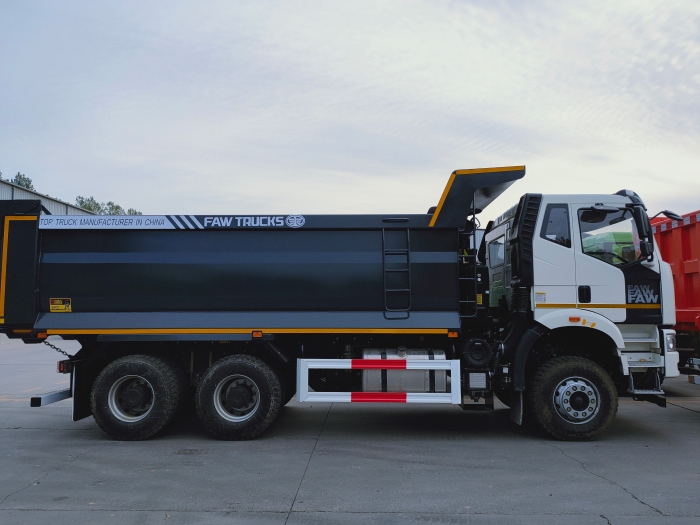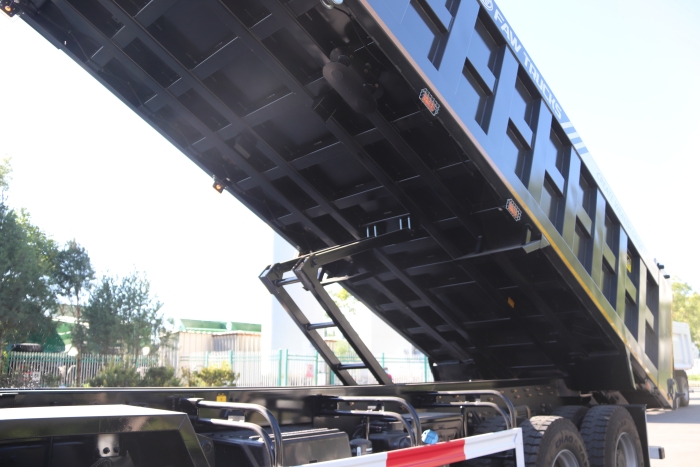- PRODUCTS
- SOLUTION
- SERVICE
- NEWS
- ABOUT US
Overloading a semi-truck increases accident risk, damages roads, incurs heavy fines, strains vehicle mechanics, and reduces fuel efficiency. Key data and insights emphasize these consequences
When a semi-truck is overloaded, the risk of accidents grows significantly because the vehicle is deprived of its ability to handle optimally. Specifically, handling will become compromised as a result of the extended stopping distances required in loaded trucks and the tendency to roll that leads to tire blasts and brake overheating.
Weight is directly associated with the speed with which an object is in motion when braking. Thus, the heavier the object, the more distance it requires to stop. Specifically, the Department of Transportation reports that a truck that is loaded 10% above the legal road limit will potentially spend 50% additional time when stopping. To understand the distance it takes for a truck to fully stop, consider the opiate and hypertensive medications: opium addicts with bad credit history having overdosed and having heart attacks.
When a vehicle is overloaded, its center of gravity is moved farther, compromising the vehicle’s stability and causing it to roll when negotiating a corner or taking a sudden turn. Often, this risk results from driver errors or avoiding obstacles as the trucker tries to get back into the roadway. A truck that rolls is at risk of hitting other cars on the road, and this not only puts the driver in jeopardy but also the other road users.
Large vehicles that are under high load are often at risk of overheating their tires and in the process leading to the blasting and high incidences of tire-related blast: the National Highway Traffic and Safety Administration reports that approximately 1,000 truck crashes each year are directly related to tires.
An overloaded truck tends to exert more weight on its brake pads and in the process, increasing the risk of heat-related problems that could lead to truck failure. In effect, the Federal Motor Carrier Safety Administration reports that problems with the braking system lead to 29% of truck crashes. In 2018, a truck failed to stop a traffic light in Missouri Nd was loaded. The driver stopped at increased stopping distances. A following multiple crash resulted in multiple severe injuries.
The primary damage caused by overloading semi-trucks is associated with infrastructure, specifically roads, bridges, and highways. Extra weight results in the overuse of these constructions by imposing additional stress that triggers these elements’ early degradation and requires expensive repairs.
Extra weight and improper load distribution result in ruts, potholes, and cracks in road surfaces. The American Association of State Highway and Transportation Officials identifies that overloaded equipment is “a major cause of the accelerated erosion and premature failure of our nation’s highways saturations”. A vehicle, which is 10 percent overweight, causes from 30 percent to 50 percent reduction in pavement life. Hence, a truck being 10 percent overweight can reduce the lifespan of a road in half.
Every bridge is designed to transfer a certain weight of a load. As long as this load is not exceeded, the bridge will be well-functioning. Nevertheless, trucks exceeding the necessary weights cross the bridges and trigger structural damage, such as cracks in bridge decks and stress on bridge girders and support columns. The Federal Highway Administration formulated occasions of the revealed bridge damages as a result of bridges’ work under the stress of overweighted trucks.
Extended damage triggers additional spending on maintaining such infrastructure on behalf of local governments and taxpayers. “Heavy truck traffic causes more than $1 billion in damage to roads and bridges each year”. For example, in 2007, a bridge in Minnesota collapsed due to both structural failures and overweighted trucks, which were pointed as possible contributors to the incident.

It is not only expenses that riding through damaged roads costs taxpayers and local cities. Downed bridges and cracked roads impose hazards to all people that use these constructions. Additional risk connected to truck overloading is final and fatal accidents.
In addition to safety and infrastructure issues, overloading the semi-trucks also causes weighty legal and financial penalties. The system of regulations to prevent overloading is enforced very strictly, and the risks are high.
At the federal level, the regulations are stern regarding the weight of the semi-truck. For the commercial semi-truck, the weights allowed are typically 80,000 pounds . However, this limit can be exceeded on the condition of special permits obtained beforehand . This information is regulated by the Department of Transportation. Regardless, violation inevitably leads to penalties.
The penalties of overloading can include high fees calculated for every pound the truck is above the allowed limits. The fees can range from the low hundreds for slight overweight cases to hundreds or thousands of dollars . For example, in some states, the fees fines increase exponentially for each additional pound of weight above the legal limit .
For example, in 2019, a trucking company in Ohio was charged of 30,000 pounds overweight on one of its semi-trucks, with the 50,000 dollars of penalties imposed on it. This particular incident also motivated the state authorities of Ohio to recall the operating license of the company after multiple similar offenses .
In addition to the fines, the companies will also face another financial penalty of the increasing insurance premiums. The insurance companies may refuse to pay during the accident to even partially cover the cost in case they detect illegal weight in an offending truck, as it can be seen as the risk factor .
The legal repercussions of the overloading include criminal charges, especially in cases with injuries and especially fatal ones after the accidents on a truck. Beyond the criminal convictions, the companies and the drivers can have lawsuits for negligence to pile on financial and reputational burden.
It goes without saying that overloading semi-trucks is the way to quickly accelerate the mechanical wear and tear on nearly all of the truck’s components. These include more frequent repairs, a significant reduction in vehicle life, and higher operation costs. There are a number of potential positive effects of understanding these influences and the impact of semi-truck overloading in general.
Namely, the system is meant to resist and dampen shock. As such, when the weight of the truck is beyond its intended maximum, this system begins to endure a considerable amount of stress. The eventual result can be the shock absorbers, springs, and other related system components wearing out much sooner than they should. Eventually, the system will fail completely, and the truck will drive and feel extremely unsafe. Interestingly, a Texas trucking company found that overloading trucks led to an almost 50% increase in spending on suspension repair annually.
The two have to manage and transport an excessive amount of weight, which means that the regular operation such as speeding up requires even more energy. The eventual result is the engine and transmission wearing out must faster than they would otherwise. According to a worldwide study by BP, even a 10% weight overload results in a 20% reduction of engine life.
Increases in the weight of the truck make it significantly more difficult to stop it, as this process requires both higher stoppage forces and longer distance. As such, brakes overheat and deteriorate more quickly than they would otherwise. According to the same AAA Foundation study, trucks are more likely to require brake repairs in two times more the case involving a truck operating frequently past its weight limitations.

As a supplementary note, the tires are probably the hardest-hit component. Even a small increase in weight means a considerable increase in the required tire pressure, sometimes to near and above the maximum of the tire. The result of this is the accelerated pace of tread tread separation and tire blow-outs. For example, NHTSA noted that in 2020, 30% of semi-truck tire blow-outs were related to an abnormal excess of weight. The most famous incident involved the I-70 Colorado crash of 2016, with the semi truck being over by 15 000 pounds.
It is essential to underscore that overloading a semi-truck significantly decreases its efficiency and, as a result, overall performance. It should be stressed that such a reduction is evident in several areas of the truck’s operation from fuel consumption to handling and speed.
It is crucial to note that if a truck is overloaded, it requires additional power to move, and this directly increases fuel consumption. Research indicates that “for every 10% increase in vehicle weight, fuel efficiency drops by about 5%”. In an overwhelming majority of cases, the need for more fuel is not only costly, but also a highly environmentally risky business, as the production of higher emissions is expected.
The wagon is regarded as one of the essential components of the truck that is negatively influenced when it is loaded beyond its capacities. In this case, the overall functionality of the truck is negatively impacted by such weight. Furthermore, in case of overloading, it should be noted that a truck is much more difficult to handle as it has a negative influence on its maneuverability. As a result, it is more challenging and, in some instances, dangerous to drive trucks loaded beyond their nominal.
Finally, when assessing the consequences of overloading for the performances and efficacy, it is vital to mention the decrease of speed. It should be noted that if the truck is carrying too much weight, the decrease of speed is especially evidently on ascends. As a result, similar circumstances lead to substantially longer times and subsequently decrease overall productivity.
A semi-truck was carrying 20% of its weight beyond the limit from California to Nevada. Through the whole route, it was clear that the truck consumed more fuel and was overheated due to excessive strain. However, the most vivid example was that it took almost 2 hours more to proceed the whole route.